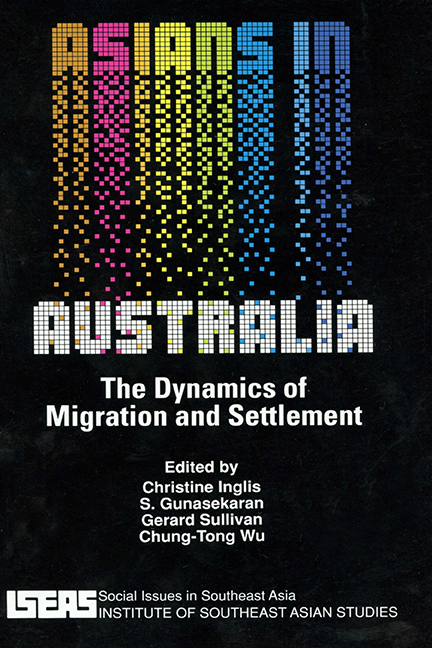Book contents
- Frontmatter
- Contents
- List of Tables
- List of Figures
- Introduction
- 1 China's Policy Towards Migrants, 1842–1949
- 2 Japanese Emigration Policy, 1880–1941
- 3 The “New” Migration and Australian Immigration Policy
- 4 Patterns of Settlement in Australia of Indochinese Refugees
- 5 Labour Market Outcomes Among the Chinese at the 1986 Census
- 6 Is There An Asian-Australian “Brain Drain”?
- 7 The “New” Migration of Asian Skills and Capital to Australia
1 - China's Policy Towards Migrants, 1842–1949
Published online by Cambridge University Press: 21 October 2015
- Frontmatter
- Contents
- List of Tables
- List of Figures
- Introduction
- 1 China's Policy Towards Migrants, 1842–1949
- 2 Japanese Emigration Policy, 1880–1941
- 3 The “New” Migration and Australian Immigration Policy
- 4 Patterns of Settlement in Australia of Indochinese Refugees
- 5 Labour Market Outcomes Among the Chinese at the 1986 Census
- 6 Is There An Asian-Australian “Brain Drain”?
- 7 The “New” Migration of Asian Skills and Capital to Australia
Summary
The Emperor's wealth is beyond computation; why should he care for those of his subjects who have left their home, or for the sands they have scraped together.
– Viceroy of Zhili, 1858China rarely expressed concern about what happened to emigrants until the later years of the nineteenth century when the worst abuses of the coolie trade and foreign pressure led to the establishment of consulates. Up to then, it was widely assumed that only barbarians lived abroad. Internal migration was always an accepted policy expedient, to reduce population pressure or to sinicize frontier regions and thus defend borders. Individuals who went further afield were expendable: riff-raff and rebels — a negative opinion reconfirmed by the anti-dynastic movement in the first decade of this century, which also brought home the message that migrant communities might, in future, require much closer watching.
By that time, the Chinese Government had already come to appreciate grudgingly that wealth or experiences gained in the outside world might assist “self-strengthening”. In any case, the mistreatment of migrants and their eventual exclusion from North America and Australasia were galling admissions of the country's international impotence. But nothing else changed China's relationship with the so-called Overseas Chinese to the same extent as the 1911 Revolution and the rise of a strong sense of enthnocentric nationalism. Just as it is proper to criticize the “White Australia” policy, it is important to understand how — by linking culture and ethnicity with nationhood — Chinese migrants also built barriers of their own, particularly in Southeast Asia where the divide-and-rule policies of colonial governments likewise encouraged communalism.
Origins of Chinese Attitudes
An old riddle asks whether the original Great Wall of China was constructed to keep the Chinese in or the barbarians out. In reality, it did neither, for when China was strong, it expanded, annexing northern Korea and Vietnam as well as Tibet and the inner Asian frontier.
- Type
- Chapter
- Information
- Asians in AustraliaThe Dynamic of Migration and Settlement, pp. 1 - 22Publisher: ISEAS–Yusof Ishak InstitutePrint publication year: 1992



